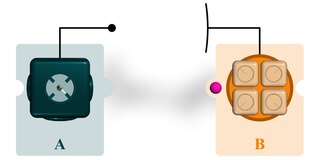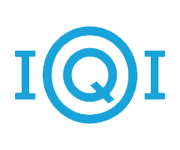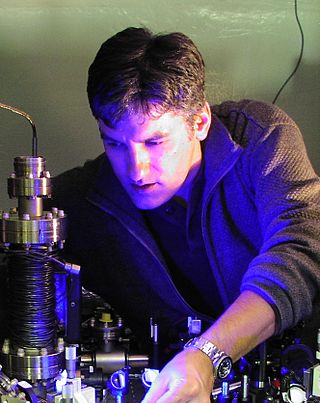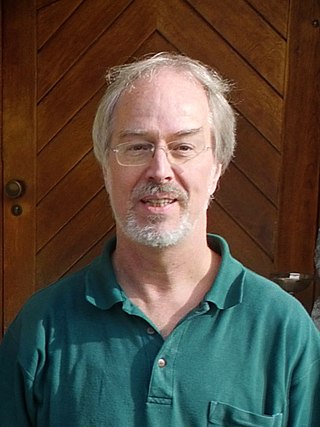
Quantum teleportation is a technique for transferring quantum information from a sender at one location to a receiver some distance away. While teleportation is commonly portrayed in science fiction as a means to transfer physical objects from one location to the next, quantum teleportation only transfers quantum information. The sender does not have to know the particular quantum state being transferred. Moreover, the location of the recipient can be unknown, but to complete the quantum teleportation, classical information needs to be sent from sender to receiver. Because classical information needs to be sent, quantum teleportation cannot occur faster than the speed of light.

Anton Zeilinger is an Austrian quantum physicist and Nobel laureate in physics of 2022. Zeilinger is professor of physics emeritus at the University of Vienna and senior scientist at the Institute for Quantum Optics and Quantum Information of the Austrian Academy of Sciences. Most of his research concerns the fundamental aspects and applications of quantum entanglement.
An atom interferometer uses the wave-like nature of atoms in order to produce interference. In atom interferometers, the roles of matter and light are reversed compared to the laser based interferometers, i.e. the beam splitter and mirrors are lasers while the source emits matter waves rather than light. Atom interferometers measure the difference in phase between atomic matter waves along different paths. Matter waves are controlled an manipulated using systems of lasers. Atom interferometers have been used in tests of fundamental physics, including measurements of the gravitational constant, the fine-structure constant, and universality of free fall. Applied uses of atom interferometers include accelerometers, rotation sensors, and gravity gradiometers.

An optical microcavity or microresonator is a structure formed by reflecting faces on the two sides of a spacer layer or optical medium, or by wrapping a waveguide in a circular fashion to form a ring. The former type is a standing wave cavity, and the latter is a traveling wave cavity. The name microcavity stems from the fact that it is often only a few micrometers thick, the spacer layer sometimes even in the nanometer range. As with common lasers, this forms an optical cavity or optical resonator, allowing a standing wave to form inside the spacer layer or a traveling wave that goes around in the ring.
Quantum networks form an important element of quantum computing and quantum communication systems. Quantum networks facilitate the transmission of information in the form of quantum bits, also called qubits, between physically separated quantum processors. A quantum processor is a machine able to perform quantum circuits on a certain number of qubits. Quantum networks work in a similar way to classical networks. The main difference is that quantum networking, like quantum computing, is better at solving certain problems, such as modeling quantum systems.
In quantum optics, a NOON state or N00N state is a quantum-mechanical many-body entangled state:

The Institute for Quantum Optics and Quantum Information (IQOQI) (German: Institut für Quantenoptik und Quanteninformation) is a member institute of the Austrian Academy of Sciences and was founded in November 2003, to create an Austrian research center for the newly developing fields of theoretical and experimental quantum optics and quantum information.
Harry Jeffrey Kimble, was the William L. Valentine Professor and professor of physics at Caltech. His research is in quantum optics and is noted for groundbreaking experiments in physics including one of the first demonstrations of teleportation of a quantum state, quantum logic gate, and the development of the first single atom laser. According to Elizabeth Rogan, OSA CEO, "Jeff has led a revolution in modern physics through his pioneering research in the coherent control of the interactions of light and matter." Kimble's main research focus is in quantum information science and the quantum dynamics of open systems.
The Leggett inequalities, named for Anthony James Leggett, who derived them, are a related pair of mathematical expressions concerning the correlations of properties of entangled particles. They are fulfilled by a large class of physical theories based on particular non-local and realistic assumptions, that may be considered to be plausible or intuitive according to common physical reasoning.

Whispering-gallery waves, or whispering-gallery modes, are a type of wave that can travel around a concave surface. Originally discovered for sound waves in the whispering gallery of St Paul's Cathedral, they can exist for light and for other waves, with important applications in nondestructive testing, lasing, cooling and sensing, as well as in astronomy.
Immanuel Bloch is a German experimental physicist. His research is focused on the investigation of quantum many-body systems using ultracold atomic and molecular quantum gases. Bloch is known for his work on atoms in artificial crystals of light, optical lattices, especially the first realization of a quantum phase transition from a weakly interacting superfluid to a strongly interacting Mott insulating state of matter.

Tilman Esslinger is a German experimental physicist. He is Professor at ETH Zurich, Switzerland, and works in the field of ultracold quantum gases and optical lattices.
In quantum mechanics, the cat state, named after Schrödinger's cat, refers to a quantum state composed of a superposition of two other states of flagrantly contradictory aspects. Generalizing Schrödinger's thought experiment, any other quantum superposition of two macroscopically distinct states is also referred to as a cat state. A cat state could be of one or more modes or particles, therefore it is not necessarily an entangled state. Such cat states have been experimentally realized in various ways and at various scales.

Christopher Roy Monroe is an American physicist and engineer in the areas of atomic, molecular, and optical physics and quantum information science, especially quantum computing. He directs one of the leading research and development efforts in ion trap quantum computing. Monroe is the Gilhuly Family Presidential Distinguished Professor of Electrical and Computer Engineering and Physics at Duke University and is College Park Professor of Physics at the University of Maryland and Fellow of the Joint Quantum Institute and Joint Center for Quantum Computer Science. He is also co-founder of IonQ, Inc.
Linear optical quantum computing or linear optics quantum computation (LOQC), also photonic quantum computing (PQC), is a paradigm of quantum computation, allowing (under certain conditions, described below) universal quantum computation. LOQC uses photons as information carriers, mainly uses linear optical elements, or optical instruments (including reciprocal mirrors and waveplates) to process quantum information, and uses photon detectors and quantum memories to detect and store quantum information.

Gerhard Rempe is a German physicist, Director at the Max Planck Institute of Quantum Optics and Honorary Professor at the Technical University of Munich. He has performed pioneering experiments in atomic and molecular physics, quantum optics and quantum information processing.

Cavity optomechanics is a branch of physics which focuses on the interaction between light and mechanical objects on low-energy scales. It is a cross field of optics, quantum optics, solid-state physics and materials science. The motivation for research on cavity optomechanics comes from fundamental effects of quantum theory and gravity, as well as technological applications.

Kerry J. Vahala is an American professor of Applied Physics at the California Institute of Technology (Caltech). He holds the Ted and Ginger Jenkins chair of Information Science and Technology and also serves as the Executive Officer of the Department of Applied Physics and Materials Science. He received his B.S. and Ph.D. degrees in Applied Physics and an M.S. degree in Electrical Engineering, all from Caltech.
Rupert Ursin is an Austrian experimental physicist active in the field of quantum entanglement and communications. He founded several companies, e.g. Quantum Technology Laboratories GmbH. and Quantum Industries GmbH and acts currently as CEO in both of theses companies.
Christine A. Muschik is an assistant professor in the Department of Physics and Astronomy at the University of Waterloo as well as a part of the Institute for Quantum Computing. She completed her PhD in 2011 at the Max-Planck-Institute for Quantum Optics. She completed postdoctoral fellowships at the Institute for Quantum Optics and Quantum Information in Innsbruck and the Institute of Photonic Sciences in Castelldefels. As of 2020, she has over 2000 citations on over 50 publications. She has also been featured in several articles in Nature magazine, MIT Technology Review, and Physics World.









